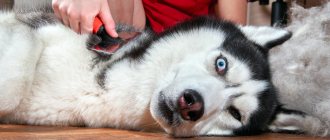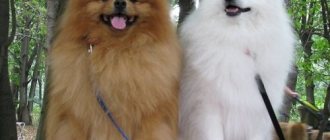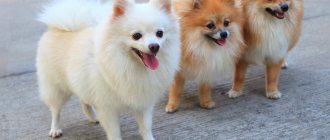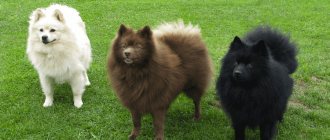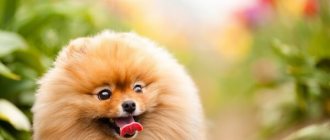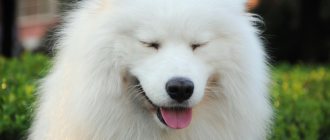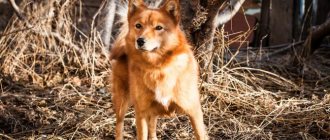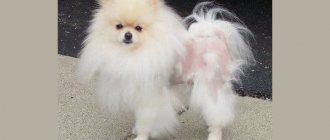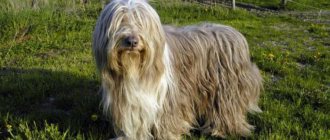Peculiarities
The hind legs are decorated with long fur that forms “pants.” The back of the front paws is covered with long feathers. Short, thick hair grows on the front of the paws, head, and ears.
The “life” period of hair consists of 4 phases: growth, regressive changes, rest, and loss. In the first phase, new hairs appear in the bulbs and begin to grow. In the second, their growth stops, the follicle enters the resting stage. The bulb begins to collapse. The hair has already grown, its root is shrinking. It is held in place by several horny scales. In the final phase, the hair falls out. A new one begins to grow from the follicle. The whole process is continuous. During molting, the resting period lengthens, the number of “dead” hairs can reach 50%. Spitz shedding takes a long time.
In an adult healthy animal, renewal of the coat occurs gradually without delay. In adult males and females that have not bred, shedding is weakly expressed. The appearance is always fine.
Special coat care
Pomeranian fur requires constant care. Bathing is carried out as needed if the pet is heavily covered in mud. There is no strict bathing schedule. The rest of the time, it is advisable to treat the dog with dry shampoo aerosol, spraying it evenly over the dog’s hair.
During the first molt, the puppy is allowed to have his hair cut, but not very short, leaving the undercoat.
Expert opinion
Anna Abramenko
An avid dog lover. Experience in veterinary medicine since 2009.
Ask a Question
It is not advisable to bathe your baby while shedding; the fluff may become matted and impossible to comb out.
Dog grooming tools:
- natural massage brush;
- slicker (only during molting);
- rare comb;
- scissors with blunt ends for trimming around the ears, anus, paws;
- dog shampoo and conditioner.
It is recommended to accustom your baby to procedures from early childhood by lightly combing him and gently stroking his back with a brush. Gradually, the Pomeranian will get used to the grooming procedure, become obedient, and begin to demand a massage.
Sometimes the fur gets matted, usually under the arms, behind the ears, or on the neck. It is recommended to comb them carefully, trying not to hurt the Pomeranian. In extreme cases, the clothes are cut out, which is unacceptable for show dogs. The appearance after cutting is greatly deteriorated.
If you purchase a grooming table, your dog will get used to it faster and be more willing to be brushed.
It is advisable to comb the fur on the animal until it is separated into partings. It is recommended to scratch the pants and withers especially carefully; this is where the hair is the longest and the hair is very thick. Brushing should be done at least once a week, more often during shedding.
It is allowed to give the orange a contour haircut and remove protruding hair of different lengths.
Types of shedding
Depending on the root causes, several types of molting are distinguished.
Age
A complex process for both the animal and the owner. It lasts from four months to a year. At this stage, the downy coat changes to a coarser type of hair. Color may also change. It begins with the loss of puppy fluff on the face, then on the body, and front legs. The last thing to shed is the pants on the hind legs and the collar.
Some puppies shed their down evenly, becoming covered with new adult fur. The most common option is that they completely shed the fluff. At the same time, the appearance changes greatly. This stage coincides with the pet's active growth and noticeable physical changes. The already grown puppy is acquiring a new coat.
The second stage is molting at the age of one year. It comes almost immediately after puppyhood. In some individuals it occurs later. All new undercoat is actively falling out. The rest of the fur falls out behind it. Junior molt can last 2-3 months. After this, the puppies acquire a tougher coat, characteristic of Spitz. The animal acquires its full form at the age of 2-2.5 years.
Seasonal
Spitz shed twice a year: in autumn and spring. The process of coat change is controlled by the main hormone of the pineal gland - melatonin. It is released in response to changes in ambient temperature and day length and causes seasonal molting.
Types of shedding in Spitz dogs
Depending on the cause, the following types of molting can be distinguished:
- Age. It begins at four months, when puppy fluff is replaced by teenage hair. The year ends when the dog acquires an adult coat. At this time, the dog is completely hairless.
- Seasonal. It occurs once a year during the birthday period and has almost no effect on the appearance of the Spitz.
- Postpartum. In girls, shedding repeats during estrus and after childbirth, when due to a lack of vitamins the dog completely loses hair.
- During illness or after it. The cause of unscheduled shedding in a Spitz may be alopecia, which is easily recognized by severe hair loss on the hind legs and tail, and dry hair. Shedding can also be a sign of allergies, thyroid disease or poor diet. In these cases, you should immediately contact a veterinarian.
Other reasons
Allergies to food, animal care products, cleaning products, and medications are accompanied by scratching, redness of the eyes, and cause hair loss around the eyes. It begins to fall out in patches on the body, and a rash appears on the skin.
An unbalanced diet and vitamin deficiency (for example, deficiency of zinc, vitamin D) can cause dry skin, dandruff, and the formation of ulcers. The Spitz will itch all the time.
Weakening of the immune system after illness is often accompanied by helminthic infestations. Parasites living in the intestines “take away” nutrients and release toxic waste products. The animal suffers from loss of fur and weight. Skin diseases may appear.
Infection with skin parasites, mites, and fungal infections is accompanied by severe scratching:
- with violation of the integrity of the skin;
- with baldness around the eyes, ears, mouth (scabies);
- with the formation of small hairless areas with a crust (lichen) on the body.
Alopecia X, or “black skin” disease, is an understudied phenomenon in Spitz dogs, accompanied by complete hair loss throughout the entire body except the head and limbs. At risk are unshed puppies aged 4-6 months and adult Spitz dogs aged 4 years. Often this disease occurs after cutting adult dogs' hair too short or when cutting soft fluff in puppies. First the fur stops growing and then falls out.
Lack of shedding during puppyhood and junior age can lead to significant hair loss, including baldness.
Hair care during shedding period
When asked by pet owners whether Spitz dogs shed, the answer is a clear yes. This is a normal process during which the animal’s coat will completely change. In order for your dog to look neat during the molting period, you need to follow the rules of care. Key recommendations include:
- During shedding, you need to bathe as needed when the dog is very dirty.
- To refresh your animal's coat, you can use special dry shampoos, which are sold in aerosol form. They treat all the dog's hair in an even layer. At the same time, you need to gently beat the wool.
- During shedding, your German Spitz breed can be trimmed to improve its appearance. But it is important to leave the undercoat intact.
Puppies need to be taught grooming procedures from a very early age. Veterinarians recommend purchasing a special table for the convenience of grooming.
Combing should begin gently, stroking the back with a brush. You need to be especially careful when combing out tangles. They occur very often in pets. They mainly appear on the neck, behind the ears and in the armpits. Sudden jerks can cause pain for your pet. Because of this, it will resist when combed out.
Attention! If the mat cannot be combed out, you can carefully cut it off. But this option is not suitable if the dog is involved in insertions. The trimmed wool will take a long time to grow back. The pet will look unpresentable.
During shedding, owners are encouraged to give their Spitz a contour cut in order to trim any protruding guard hairs.
During the shedding period, veterinarians may prescribe vitamins and minerals for your dog. This is especially true for pets that are kept on a natural diet. During a coat change, a Spitz lacks zinc, manganese, vitamins A, C, E and B. Only a doctor should determine the dosage. It is prescribed depending on the age and weight of the dog.
During the molting period, it is necessary to comb your pet thoroughly to avoid the formation of tangles.
When to go to the vet
If hair loss is excessive and not periodic, you should consult a doctor.
Main warning symptoms:
- absence of change of downy hair to a coarser adult coat under the age of one year;
- dull, brittle, thinned coat without volume;
- hair loss around the genitals and throughout the body without signs of skin damage or itching;
- local hair loss, accompanied by severe itching and skin damage;
- baldness of the areas around the eyes, accompanied by itching of the skin, redness of the eyes;
- the formation of large bald spots throughout the body, except for the limbs and head, followed by darkening of the skin.
You may need to take a blood test for biochemistry and a general blood test. Based on the results, the veterinarian will prescribe a course of treatment.
To prevent skin diseases, your dog needs to be vaccinated.
Types of shedding in Spitz
Pomeranians can shed for a variety of reasons. Shedding can be:
- age;
- seasonal;
- shedding associated with estrus in bitches;
- unscheduled.
The first three types of shedding are completely natural and do not require complex care. In these cases, you just need to comb the wool regularly so as not to collect it on the furniture and floor. Another thing is unscheduled. Unscheduled shedding can be caused by various irritants. In case of unscheduled molting, careful care and treatment of the pet is necessary.
Age-related molting
The first molt is the change from fluff to adult fur. This happens from four months to the end of the year.
The second shedding of a Spitz occurs at the age of 1 year. The shedding process for each dog is individual, some change their coat immediately, while for others the shedding process takes a long time.
In both cases, at the peak of shedding, there is very little fur on the puppy. During these periods, it is even difficult to understand at first glance that the pet is a Pomeranian Spitz.
Puppy shedding stages:
1. The photo shows a Pomeranian Spitz of orange color. The fur at the first stage is lush and thick. There is not a hint of bright orange on the puppy. Now the fur is the color of gray sable. The puppy in the photo is only 2.5 months old, and will soon begin its first molt.
2. At 4 months, shedding is already noticeable. The undercoat is already quite thin. Adult fur of bright color appeared on the face and paws.
3. At 6 months, the molting process continues, the puppy is already almost entirely orange. Since the fur is just growing, the pet does not look very fluffy. Forum users say that around this age the shedding looks most pronounced. Owners will never see their pets this bald again.
After all stages of puppy shedding, the coat begins to become more and more voluminous and thick. Then the puppy is already waiting for its first seasonal molt.
Seasonal molt
All subsequent molts take place once a year, at approximately the same time. Basically, Pomeranian shedding begins around the day of birth, so if the puppy was born in the summer, then the Pomeranian shedding will be summer, while the Spitz will shed winter in those dogs that were born in winter. During seasonal shedding, your Spitz can only be cut by a qualified professional. Incorrect trimming can further damage the coat. But brushing must be done regularly. Bathing a Spitz is highly not recommended. Water procedures significantly increase hair loss. Spitz summer shedding is a period that takes place during the summer season. This shedding is almost unnoticeable; the dog does not change all of its fur, but sheds some of the axial hair. This is due to the high air temperature.
Shedding during estrus in bitches
Spitz girls have another scheduled molt, unlike males. In addition to the annual shedding, girls shed a little during estrus, as well as during the nursing period of the puppies, approximately two or three months. During lactation, the female Pomeranian sheds because she feels a lack of vitamins and minerals. The wool does not receive all the necessary nutrients, weakens and falls out.
Unscheduled molt
There is also unscheduled shedding, in which the Spitz sheds its hair year-round. This may be due to inappropriate nutrition or some kind of disease in the Spitz. Parasites, allergies and other diseases affect not only the general condition of the pet, but also the coat. Contacting a veterinarian is mandatory. It is necessary to take a blood test, and the doctor will prescribe the correct course of treatment. Poor nutrition causes a lack of vitamins. In this case, you need to change your pet’s food and supplement it with vitamin complexes.
Grooming during shedding
In order for this difficult period to pass without problems for you and your pet, you need to stock up on special tools and care products.
During shedding, daily brushing with a special massage brush with long metal teeth is allowed. For puppies from two months of age, a brush with soft bristles is suitable. It is passed over the wool in different directions. Such actions will prevent tangling and tangles. Regular brushing will increase blood circulation and improve the supply of nutrients to the epidermis.
You can use a slicker or furminator, which allows you to remove up to 80% of dead hair. Using this tool significantly reduces molting time.
Do not forget about areas of the body covered with short velvety hair: part of the head, ears, front parts of the paws. To care for them, use a comb with sparse or large teeth.
Bathing Spitz dogs during this period is not advisable. During washing, the fur becomes soft and gets into tangles that are difficult to comb. Therefore, the animal can be bathed only if it is heavily soiled or before an exhibition.
It is not advisable to trim your Spitz during shedding. A short haircut can lead to a complete cessation of hair growth.
Spitz coat care
A Spitz's coat is its pride, which is why many dog breeders love it so much. The Spitz looks like a fluffy ball, thanks to the stiff axial hairs that raise the thick undercoat. For a Spitz's coat to look good, it needs proper care, especially when the Spitz is shedding.
Equipment needed for care:
- combs with frequent and rare teeth;
- metal massage brush;
- suitable shampoo, conditioner or sprays that maintain the brightness of the coat color and prevent matting;
- scissors must have blunt tips to give an aesthetic appearance during shedding (trimming the hairs on the ears and paws).
It is necessary to accustom your Spitz to grooming from a very young age, so that later there will be no problems with combing and bathing. The pet should love being cared for and be calm during the procedures.
Deviations from the norm: when to go to the veterinarian
If the fur falls out too much, or begins to smell unpleasantly or smell excessively like a dog, contact your veterinarian immediately.
The main signs to be concerned about are:
- there was no change from down to adult fur until one year old;
- the wool has no volume, is very dull and brittle;
- hair loss occurs around the genitals and throughout the body without itching or damage;
- hair loss, accompanied by itching and redness of the eye mucosa;
- the appearance of large bald spots on the dog’s body with the exception of the paws and head, followed by darkening of the epidermis.
If there is a deviation from the norm, the pet should be taken to a doctor
Most likely, you will have to undergo a biochemical and general blood test. Based on the results, the doctor will prescribe medication.
To avoid most problems, vaccinate your animal in a timely manner.
Spitz fur is thick and lush. Looking at dogs of this breed, many sympathize with the owners who have to constantly brush their pets. But experienced dog breeders know all the intricacies of caring for Spitz fur and do everything so that even during molting, the smiling “bear cubs” retain their main trump card.

